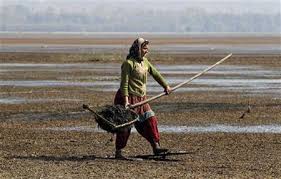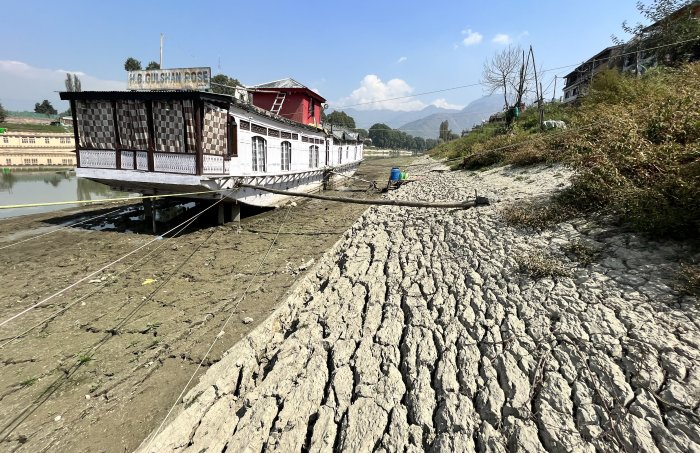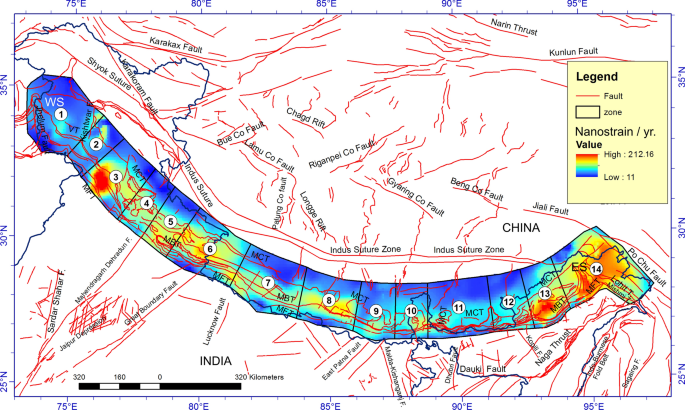World Wetlands Day
Approximately 13 tons of solid waste is dumped per day on Wullar banks
 Wetlands play an important role in keeping the ecological processes healthy. They support industries such as agriculture, fisheries and tourism by supplying valuable source of water for irrigation and domestic use, fodder for domestic livestock, maintaining water quality, providing habitat for commercial species and having cultural and recreational values.
Wetlands play an important role in keeping the ecological processes healthy. They support industries such as agriculture, fisheries and tourism by supplying valuable source of water for irrigation and domestic use, fodder for domestic livestock, maintaining water quality, providing habitat for commercial species and having cultural and recreational values.
Wetlands host a huge variety of life, protect the coastlines, and provide natural defences (sponges) against river flooding or storm surges and store carbon dioxide to regulate climate change. Unfortunately, wetlands are often viewed as wasteland, and more than 64 percent of the world’s wetlands have disappeared since 1900.
More than a billion people make a living from wetlands. Livelihoods from fishing, rice farming, travel, tourism, and water provision all depend on wetlands and are vital to us in many other ways. Enabling people to make a decent living, and at the same time ensuring that wetlands can still provide their essential benefits, do not have to be conflicting goals by jeopardizing their ecological and socio-economic values. Recognizing the importance of biodiversity, ecological and socio-economic values of the wetlands, Convention on Wetlands of International Importance called the Ramsar Convention was signed on February 2, 1971, in the Iranian city of Ramsar. As such, celebrating the World Wetlands Day provides opportunity to raise public awareness and promote the value of wetlands and marks the anniversary of the date of signing of the Ramsar Convention.
Ramsar Convention on Wetlands is an intergovernmental treaty that provides the framework for national action and international cooperation for the conservation and wise use of wetlands and their resources especially as of Waterfowl Habitat (biodiversity), socio-economic values and sustainable utilisation of wetlands, recognising the fundamental ecological functions of wetlands and their economic, cultural, scientific, and recreational value.
India became a contracting party to the Ramsar Convention in October 1981 by designated Chilika Lake (Orissa) and Keoladeo National Park (Rajasthan) as its first two Ramsar sites and entered into force as a Ramsar Contracting Party (Member State) on February 1, 1982. Jammu Kashmir is having four Ramsar sites wetlands covering an area of 326.25 sq km. It includes Hokersar, Surinsar-Mansar, Tso Morari and Wullar Lake.
Wullar Lake
Wullar Lake is located in north Kashmir’s Bandipora district. It is elliptical in shape with a maximum length of 16 kms and breadth of 7.6 kms having depth of about six meters. The lake is surrounded by towering snow bound peaks of Himalayas in its Northeast and Northwest which directly drain their runoff into the lake through various streams, Arin and Madhumati streams being prominent. On the banks of the Wullar Lake lies a Bandipora, under foothills of Himalayan lush green forests and snowbound peaks of Harmukh (16900 feet), Razdaan (11500 feet) and Tragbal (11000 feet) amid various high altitude glaciated lakes (Sars) like Shirasar, Gangbal, Tar Sar, Mar Sar, Kounsarnag, and Alipathar between 3000-4000 m, known as direct catchment extending to an area of 1144 sq km comprising of six water sheds, and its sub catchment linked to Jehlum river basin drain their run off into Wullar Lake.
Though, various estimates exist as the lake has not been properly investigated. Hundred years ago, area of the Wullar Lake was 189 square kilometers, which in floods extended up to 273 square kilometers. In some chronicles, however, the area of the lake has been recorded as 210 sq kms, Kalhans Rajtarangni shows the area of the lake during floods as 273 square kilometers and 189 sq kms in normal times. Lawrence in his “Valley of Kashmir” shows area of the lake as 189 sq kms in normal times; Aurial Steins described area of the lake as 202 sq kms in normal times.
However, the Directory of Wetlands Ministry of Environment and Forests Government of India showed area of the lake as 189 sq kms. The satellite imagery of 1996 by Department of Ecology and Environment JK, area of the lake in floods extends up to 120 sq km and in normal times it is 79 sq kms. But the Revenue Department, in a survey during 2006-07 showed the lake area as 130 sq km including an area of about 35 sq km encroached under willow plantations.
During the last six decades, however, due to political reasons, low lying areas of the lake from Sonawari were reclaimed for the agricultural activities and protection bunds were raised inside the lake still existing in the name of Bakhshi Bund and Sheikh Bund (1st and 2nd Line 0f Defence) to protect the encroached settlements.
Although, the deterioration of the lake was assigned during the Dogra Rule in Kashmir either for revenue generation by pawing way to irrigation projects which then was united Punjab in 1902 or with the establishment of Ningli Plantations in 1920 to meet the firewood requirements in Kashmir, which ultimately resulted not only in the deterioration of hydrologic and ecologic values of the wetland but also squeezed the lake area. Due to land reclamation, population explosion, wanton deforestation, overgrazing, Ningli Plantations, unscientific sewage and sewerage disposal, excessive use of fertilizers, pesticides in the catchments and above all the miserable socio-economic plight of the people of the lakeshore and catchments, the lake body has been passing through hard times. Huge rate of silt and sediment mainly through River Jehlum has reduced the extent of lake area to 72 sq kms at present. Thus, a vast aquatic ecosystem is transformed into a big aquatic pool.
Wullar Lake has a significant role in the hydrology and ecology of Kashmir and the socio- economy of the area. The lake serves as a huge absorption basin for entire Kashmir and acts as a main storage tank for the floods as witnessed in the recent (September 2014) devastating floods which submerged entire Srinagar city besides hitting Kashmir from north to south with sorrowful destruction, but the Lake Wullar with its vivacious embracement took the brunt, preserving its splendid past.
With a huge potential of irrigation and hydroelectricity generation the lake can act to boon the Kashmir economy.
Wullar acts as a big wetland reserve (ecosystem) with a quite diverse range of flora and fauna including micro flora, hydrophytes, epiphytes, fisheries, native and migratory birds and other aquatic animals inhabiting it. Besides its ecological features the lake, also has a great potential of socio-economic features. There are overall 127 settlements around the lake and its direct catchments within district Bandipora 80 percent and Baramulla district 20 percent from Watlab to Ningli containing a population of 0.46 million which is nine percent of Jammu Kashmir’s population.
The lake is a direct source of income to thousands of families living on its shoreline. Fishing in the lake is carried at a great extent by the lakeshore community which contributes about 55 percent of fish yield of Kashmir. The common species of fish in the lake are Schizothorax esocinus, S. curvifrons, and S. planifrons. An estimated population of about 35000 is directly or indirectly related to lake resources, fish capturing being main occupation of 2400 households with an estimated 3200 active fishermen to sustain their livelihood among the lakeshore community and rest being related to the trade limited value addition process.
While men are engaged in fishing, women undertake the marketing and related operations. Several plant species are used for mat and basket weaving, bat manufacturing and other purposes. Trend analysis through Participatory Resources Appraisal (PRA) during the formulation of Comprehensive Management Action Plan for Wullar Lake in 2006-07, however, it revealed a drastic decrease in the fish capture and other lake resources over the last five decades.
Many people put their heart and soul together by selling the rhizome of lotus Nelumbo nucifera commonly known as Nadru obtained from the lake, which are highly fibrous and rich in calcium, and iron besides water chestnut or Singhara (Trapa natans) also sold in bulk. Waterfowls, however, are also sold occasionally by the lakeshore people for their livelihood. Many hydrophytes growing in the lake serve as important fodder species like Nymphoides peltea, Nymphaea alba and other microphytic species from deeper water as Cerataphyllum demersum, Myriophyllum spicatum Potamogeton sp., Phragmites communis and Typha augusta of which two main species are used on large scale for the cattle locally known as Nar and Khor, thus generating a substantial economy and sustaining the livelihoods.
Wullar with its associated wetlands like Hokarsar, Hygam, Shalbug, Malgam, and Mansbal is an important habitat for migratory water birds and support a rich diversity. The direct catchment (Bandipora Himalayas) of the lake supports coniferous forests occurring between 2100-3200 m msl, being temperate, dominated by Deodar (Cedrus deodar), Kail (Pinus excelcia ), Pinus roxburgy, Pinus welichiana, Silver fir (Abies webiana ), Fir ( Abies pindrow ), Kachhil (Picea morinda ) and Birch (Betula utilus) species.
Alpine pastures immediately follow the tree line in the catchment between 3200m-3600 m msl. The tree growth ends with Birch, Junipers and Rhododendrons in between 3600-4100 m msl. The terrestrial birds observed around the lake are black eared kite, sparrow hawk, short toed eagle, Himalayan golden eagle, Monal, Chakur, Koklas, Blue rock pigeon, Cuckoo, Kashmir roller, Himalayan pied wood pecker, Hoopoe, Kashmir skylark, common swallow, golden oriole etc.
Many migratory waterfowl species visit the lake like pintail, common teal, gargey teal, shoveled, blue winged teal, common pochard, mallard, brahimini duck, greleg goose, white breasted water hen, lapwing, Indian moorhen, coot etc.
In past the Lake served as an important center of navigation with Gurez-Bandipora pony track (Silk Route) being a prominent land link between Kashmir-Kargil, Iskardu, Gilgit and Common Wealth of Independent States to reach Karachi seaport via Jhelum river emerging Bandipora (Khoihama) as the port of Wullar.
The highly mountainous terrain is marked with a series of high ridges and narrow deep valleys, which have a pronounced effect on the climate of the region with various types of local winds with strong currents. The lake is frequently subjected to these types of winds and stormy conditions which is a characteristic feature of the lake as compared to other lakes of Kashmir and as such the lake is full of hurricanes in the afternoon which sweep with high tides even up to 15 feet with extra ordinary violence posing threat to tourists and fishermen.
Recognizing the importance of the lake for its biodiversity, socio-economic, hydraulic and ecologic values the lake was designated as the wetland of international importance under the Ramsar Site in 1990 (Site No.461, Dated 23/03/1990).
Lack of understanding of values and functioning of Wullar and its associated wetlands (mainly due to political reasons) has led to conversion of its large area for agriculture, settlements, plantations and other developmental activities. All along the Wullar periphery particularly in Sonawari area the wetlands were drained through government sponsored programmers for agricultural development. Bunds were built up at various lake contour levels for the protection of the crops and the settlements against the floods thereby fragmenting the lake ecosystem and changing its ecological character.
Wullar Lake is seriously threatened due to exploitation of the lake resources and degradation of the lake catchments mostly due to population explosion, hence the consequent growing demands for land, food and fuel. The free flow of untreated sewage and sewerage, large quantities of fertilizers, insecticides, pesticides used in the catchment orchards and animal wastes find their way into the lake body with Jhelum river passing through highly urbanised areas bringing along with heavy load of silt and hazardous hospital waste including Srinagar city, from lakeshore towns of Sonawari, Bandipora (approximately 13 tons of solid waste is dumped per day on the banks of Wullar alone by the Municipal Committee Bandipora despite the High Court orders) and its adjoining areas.
Solid waste generation with an average of 0.350 gm/capita/day from the adjoining periphery and an extra load of muck generated from Kishanganga Hydroelectricity Power Project in Bandipora by NHPC and HCC is illegally either directly or indirectly dumped into Madhumati stream, a prime tributary of Wullar lake thereby posing severe threat to the aquatic life and the ecology of the lake. The rich biodiversity of the lake is deteriorating rapidly on account of unsustainable economic development.
Sectoral development activities, however, failed to recognize the immense role of the Wullar Lake leading to its degradation including the revenue centric approaches followed by the state government. It was aimed at the short term economic benefits without realising their long term implications on the overall sustainability on the lake ecology and livelihood opportunities. Measures were undertaken during early twentieth century by then government (Dogra Rulers) to facilitate the irrigation projects for high agriculture production to the united Punjab and to provide the firewood to Kashmir by initiating the willow plantations in 1916 in the marshy areas.
Hence, Ningli plantations were established in 1924.
The conversion of these marshes into plantations which were highly productive to local communities proved counterproductive. A survey by the Revenue Department in 2006-07 by the order of the Honble High Court of J&K to demarcate the Wullar and Manasbal Lakes after acting on a PIL dossier by KEPCO, revealed that an area of 34.88 sq km (3488.52 Ha.) is encroached by the willow (Salix spp) and other plantations.
Besides the forest department, many other government departments jumped into the fray bringing the silted areas, fringes, and peripheries under the wetland plantations including Social Forestry, Revenue, Rural Development, Rakhs and Farms which accounts for encroachment to 88 percent (3084.38 ha) of which Rakhs and Farms accounts for 48 percent that is 1,660.18 ha, Forest Deptt 38 percent that 1,337.05 ha, Panchayats two percent that 55.23 ha, Social Forestry about one percent that is 12 ha. While a least 12 percent that is 404.14 ha plantation encroachment exists by the local communities, which speaks the criminal negligence and callous attitude of the government agencies.
Land reclamation by the Rakhs and Farms for the agriculture purpose and raising of such plantations has certainly altered the hydrological processes of the wetland which acts as barriers to silt laden waters of the river Jhelum, forcing it to discharge the sediment load into the lake thereby inducing loss of water holding capacity. Thus once Asia’s largest fresh water wetland Wullar has been practically turned into a woodland and reducing the overall lake area by about 50 percent.
Due to invasion of many weeds the marshy and shallow zones of the lake are infested by silt and sediment while due to extra ordinary increase in nitrogen, phosphorus and potassium level the water quality of the lake is fast deteriorating.
The chlorine content of the wetland is much higher in comparison to other wetlands, which is an indicative of organic pollution of animal origin. The depth of the lake is lost considerably as obnoxious weeds and innumerable phytoplankton and zooplankton have invaded the lake while the extent of the marshes around the lake has drastically increased.
Red bloom is signaling the eutrophication of the wetland.
Due to untreated sewage and sewerage being directly or indirectly thrown into the lake, most of the effluents from almost entire Kashmir are drained into the lake along with the different non degradable components and carcasses accumulating the hazardous water. Decline in resource base and limited opportunities for livelihood diversification have lead to poverty and reduced quality of life of the communities living around the lake and its catchments. The prevalence poverty is between 41 percent to 52 percent in these communities which is quite high when compared to overall average of 3.91 percent.
Hence a strong expertise opinion arises that river Jhelum, biggest source of pollution for Wullar Lake, needs to be diverted partially from its entry point (Banyari) to its outlet (Ningli) through a bypass water channel via Shahgund with adequate gauges at both the places to regulate the water flow into the lake.
Lack of regulatory mechanism for the integrated management has led to cross sectoral conflicts and overall degradation of the lake and its resources. Lack of coordination among various departments ultimately proved disastrous for the survival of the lake, despite Department of Wildlife Protection being nodal agency for management of Ramsar Site Wetlands.
Owing to these indifferences and lack of coordination, Kashmir Environmental Protection Coordination Organization (KEPCO), started the Save Wullar campaign in 2004. In the Regional Conference (Northern States) Ramsarsite Wetlands-2005 at SKICC Srinagar during a presentation Wullar – a Vanishing Lake by KEPCO, various international dignitaries and other participants were briefed over the deterioration of Wullar Lake. In 2006, KEPCO after an extensive volunteer field work for two years filed litigation in the Honble High Court seeking its legal intervention into the matter.
The J&K Government was directed to demarcate both the wetlands and formulate an action plan on Wullar Lake through an international wetland consultancy. Hence the Government of Jammu Kashmir engaged a reputed global wetland consultancy Wetlands International South Asia (WISA) to formulate a Comprehensive Management Action Plane on Wullar Lake.
The Comprehensive Management Action Plan envisaged establishment of the Wullar Development Authority (WDA), in the Department of Wildlife Protection under overall control of the Forest Department. The Wullar Development Authority – Governing Body would serve as Executive Board chaired by the Chief Minister/Chief Secretary and responsible for overall policy directions and performance. Wullar Development Authority will have a Wullar Steering Committee, a high level empowered committee responsible for the inter department cooperation and overall achievement of the project. Project Implementation Committee, Scientific and Community Advisory Groups, Project Management Unit are proposed within WDA, for the implementation of Comprehensive Management Action Plan.
The Conveyer of these Committees will be the Chief Executive of Wullar Development Authority. Major thrust so far has been on the Dal Lake ignoring the Wullar. JK Government, however, created the Wullar Mansbal Development Authority (WMDA) under the aegis of Tourism Department for the tourism development, which in no way was competent over the Wullar Lake conservation, management and planning issues.
Although, the government established the Wullar Conservation and Management Authority in 2010 to ensure the conservation and management planning of the wetland but a significant change by involving the experts and stakeholders is yet to appear.
The vanishing Lake needs conservation rather than depleting our rich ecology by the so-called tourism promotion. However, the traditional tourism needs to be replaced through eco-tourism promotion with educational and interpretation services at latter stage. Frequently subjected to winds and stormy conditions, a characteristic feature of the lake as compared to other lakes of Kashmir, Wullar Lake is full of hurricanes during the afternoons which sweep high up to 15 feet with extra ordinary violence capsizing the boats with fatal incidents.
Owing to this fatal character of the lake, ecotourism promotion needs to be prioritised with the lifesaving measures to the tourists, a pre-requisite for safe Wullar trip and recreational activities. Traditional boat riding may be replaced with the medium size steamers, life guards and the lifesaving ambulances equipped with the latest communication technology for the timely action against any eventuality.
Other recommendations like demarcation, removal of Ningli and other plantations to enhance the water holding capacity, water quality improvement, installation of the sewerage treatment plants (STPs) at the specific locations of which a 4 MGD STP to be installed at Bandipora, environmental flow assessment, catchment conservation to avoid the soil erosion in degraded forests, alternative sources of energy to reduce the dependence on forests for firewood and charcoal, biodiversity conservation to ensure the habitat restoration and rehabilitation of threatened and endangered species, wildlife conservation through the establishment of wildlife and bird sanctuaries in the catchments of Bandipora at Arin and Harmukh peak.
Awareness among the local communities and general public about the importance of Wullar Lake ecology, hydrology and socio-economy should be followed in accordance with the management action plan. Livelihoods improvement and community participation of the lakeshore communities (the stake holders), to overcome their socio-economic plight through enhancement of sustainable fisheries development and nelumbo yield and diversity would be critical one with improved technology of landing, storage and marketing facilities at the specific locations to abolish the middleman system.
Establishment of Schizothorax fish seed farm to revive the fast dwindling native fish species and restocking in the lake would help its revival not only in Wullar but also in the entire river system along with its associated wetlands. Strengthening of landing centers for monitoring the yield, provision of improved crafts and gears, enhancing live fish storage capacity and post harvest management would ensure sustainable fisheries development.
Revival and strengthening of fish cooperative societies to reduce the exploitation by the middleman will augment the income generation of the local communities who depend upon these resources for their livelihoods while an effective monitoring and evaluation framework will ensure integrated conservation of wetland and sustainable livelihood improvement of dependent communities.
The local communities and the common people along with the government have to play their role in Wullar Lake conservation without jeopardizing the nature’s special gift supplies of the wetland. Wullar Lake is an inseparable component of socio-economic and ecological heritage of Kashmir and we should do everything to save it.
The author can be mailed at tahamubashir22@gmail.com






